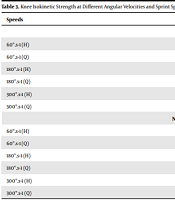The Association Between Sprint Speed Test and Isokinetic Knee Strength in Healthy Male Volleyball Players
DOI:
https://doi.org/10.61838/kman.intjssh.4.2.8Keywords:
Volleyball Player, Isokinetic, Strength, SpeedAbstract
Background: Volleyball is a sport with technical elements and explosive power. Objectives: This study investigates the relationship between sprint speed and isokinetic knee strength applied at different angular velocities in male volleyball players. Methods: This study was conducted on 15 volunteer male volleyball players (age; 17 - 25 years, height; 1.75 + 0.12 m). Isomedx 2002 isokinetic dynamometer is employed to measure the isokinetic strength, and a 20 m sprint test is conducted to measure the speed. In measuring knee flexion and isokinetic extension strength, quadriceps and hamstring concentric/eccocentric are measured separately on both legs at 60°/sec angular velocity for three repetitions, at 180°/sec for six repetitions, and at 300°/sec for nine repetitions. For statistical analysis, the Spearman’s correlation test was performed using SPSS 18.0 (SPSS Inc., USA) software. Results: The highest torque value in subjects was recorded on both sides at 60°/sec angular velocity, 180 and 300 degrees, respectively, were lower. There was no significant relationship between speed and isokinetic strength at different angular velocities. Conclusions: Based on our results, the highest peak torque in volleyball players was found to be at 60°/sec angular velocity while no significant correlation was found between isokinetic strength of the knee at different angular velocities and speed of volleyball players.Downloads

Downloads
Published
2022-05-17
Issue
Section
Articles
How to Cite
Didehdar, D., & Kharazinejad, A. (2022). The Association Between Sprint Speed Test and Isokinetic Knee Strength in Healthy Male Volleyball Players. International Journal of Sport Studies for Health, 4(2), 59-63. https://doi.org/10.61838/kman.intjssh.4.2.8




